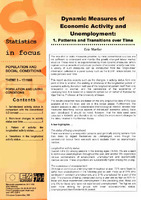| dc.contributor.author | Eurostat |
| dc.date.accessioned | 2020-12-03T12:22:28Z |
| dc.date.available | 2020-12-03T12:22:28Z |
| dc.date.issued | 1999-07 |
| dc.identifier.issn | 1024-4352 |
| dc.identifier.uri | https://ketlib.lib.unipi.gr/xmlui/handle/ket/3344 |
| dc.description | Statistics in focus, population and social conditions theme 3-17/1999 |
| dc.description | Downloaded from EU Bookshop. |
| dc.description | http://aei.pitt.edu/id/eprint/85183 |
| dc.description.abstract | The one-shot or static measures provided by most conventional sources are not sufficient to understand and monitor the greatly changed labour market situation. These need to be supplemented by more dynamic measures, which capture various aspects of individuals' patterns of economic activity over time. A variety of such measures can be constructed from the 'longitudinal' information collected in a panel survey such as the ECHP, which follows the same persons over time. This report studies aspects such as the changes in activity status from one point in time to another, the stability or otherwise of the longitudinal pattern of economic activity, transition matrices of the longitudinal pattern itself from one time-period to another, and the persistence of the experience of unemployment. It is based on a research carried out on behalf of Eurostat by Vijay Verma, Professor at the University of Essex. |
| dc.format.extent | 8p. |
| dc.language.iso | en |
| dc.publisher | Eurostat |
| dc.subject | Employment/ Unemployment |
| dc.subject | Economic Activity and Unemployment |
| dc.title | Statistics in Focus: Population and social conditions. Dynamic Measures of Economic Activity and Unemployment: 1. Patterns and Transitions over Time. 1999.17 |
| dc.type | working document |
| dc.publisher.place | Luxembourg |

